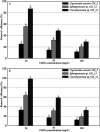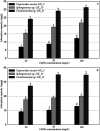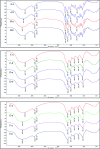Adsorption of cadmium by live and dead biomass of plant growth-promoting rhizobacteria
- PMID: 35548138
- PMCID: PMC9086479
- DOI: 10.1039/c8ra06758a
Adsorption of cadmium by live and dead biomass of plant growth-promoting rhizobacteria
Abstract
Plant growth-promoting rhizobacteria (PGPR) have been extensively investigated in combination remediation with plants in heavy metal contaminated soil. However, being biosorbent, few studies of live and dead cells of PGPR have been undertaken. Meanwhile, the application of live or dead biomass for the removal of heavy metals continues to be debated. Therefore, this study uses living and non-living biosorbents of Cupriavidus necator GX_5, Sphingomonas sp. GX_15, and Curtobacterium sp. GX_31 to compare their Cd(ii) adsorption capacities by SEM-EDX, FTIR, and adsorption experiments. In the present study, whether the cells were living or dead and whatever the initial Cd(ii) concentration was, removal efficiency and adsorption capacity can be arranged as GX_31 > GX_15 > GX_5 (p < 0.05). However, removal efficiency in live and dead biosorbents was quite different and it greatly affected by the initial Cd(ii) concentrations. The dead cells exhibited a higher adsorption capacity than the live cells of GX_31. Nevertheless, for GX_5 and GX_15, the loading capacity of the non-living biomass was stronger than that of the living biomass at 20 mg L-1 of Cd(ii), but the capacity was similar at 100 mg L-1 of Cd(ii). Minor changes of spectra were found after autoclaving and it seemed that more functional groups of the dead biosorbent were involved in Cd(ii) binding by FTIR analysis, which also illustrated that the hydroxyl, amino, amide, and carboxyl groups played an important role in complexation with Cd(ii). Based on these findings, we concluded that the dead cells were more potent for Cd(ii) remediation, especially for GX_31.
This journal is © The Royal Society of Chemistry.
Conflict of interest statement
There is no conflict of interest and all the authors are interested to publish the manuscript.
Figures






Similar articles
-
Adsorption of Cd (II) by a novel living and non-living Cupriavidus necator GX_5: optimization, equilibrium and kinetic studies.BMC Chem. 2023 Jun 14;17(1):54. doi: 10.1186/s13065-023-00977-4. BMC Chem. 2023. PMID: 37316907 Free PMC article.
-
Biosorption and bioaccumulation characteristics of cadmium by plant growth-promoting rhizobacteria.RSC Adv. 2018 Sep 3;8(54):30902-30911. doi: 10.1039/c8ra06270f. eCollection 2018 Aug 30. RSC Adv. 2018. PMID: 35548749 Free PMC article.
-
Characterization of cadmium-resistant rhizobacteria and their promotion effects on Brassica napus growth and cadmium uptake.J Basic Microbiol. 2019 Jun;59(6):579-590. doi: 10.1002/jobm.201800656. Epub 2019 Apr 25. J Basic Microbiol. 2019. PMID: 30980735
-
Biosorption of Cd(II) by live and dead cells of Bacillus cereus RC-1 isolated from cadmium-contaminated soil.Colloids Surf B Biointerfaces. 2013 Jul 1;107:11-8. doi: 10.1016/j.colsurfb.2013.01.062. Epub 2013 Feb 9. Colloids Surf B Biointerfaces. 2013. PMID: 23466537
-
A New Strategy for Heavy Metal Polluted Environments: A Review of Microbial Biosorbents.Int J Environ Res Public Health. 2017 Jan 19;14(1):94. doi: 10.3390/ijerph14010094. Int J Environ Res Public Health. 2017. PMID: 28106848 Free PMC article. Review.
Cited by
-
Bioaugmentation of Vibrio alginolyticus in phytoremediation of aluminium-contaminated soil using Scirpus grossus and Thypa angustifolia.Heliyon. 2020 Sep 21;6(9):e05004. doi: 10.1016/j.heliyon.2020.e05004. eCollection 2020 Sep. Heliyon. 2020. PMID: 33005804 Free PMC article.
-
Adsorption of Cd (II) by a novel living and non-living Cupriavidus necator GX_5: optimization, equilibrium and kinetic studies.BMC Chem. 2023 Jun 14;17(1):54. doi: 10.1186/s13065-023-00977-4. BMC Chem. 2023. PMID: 37316907 Free PMC article.
-
Improvement of Zn (II) and Cd (II) Biosorption by Priestia megaterium PRJNA526404 Isolated from Agricultural Waste Water.Microorganisms. 2022 Dec 19;10(12):2510. doi: 10.3390/microorganisms10122510. Microorganisms. 2022. PMID: 36557763 Free PMC article.
References
LinkOut - more resources
Full Text Sources

